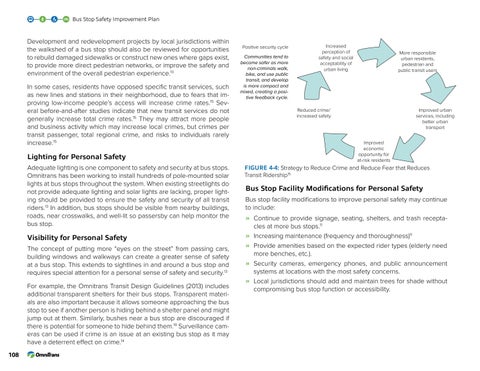Bus Stop Safety Improvement Plan
Development and redevelopment projects by local jurisdictions within the walkshed of a bus stop should also be reviewed for opportunities to rebuild damaged sidewalks or construct new ones where gaps exist, to provide more direct pedestrian networks, or improve the safety and environment of the overall pedestrian experience.13 In some cases, residents have opposed specific transit services, such as new lines and stations in their neighborhood, due to fears that improving low-income people’s access will increase crime rates.15 Several before-and-after studies indicate that new transit services do not generally increase total crime rates.15 They may attract more people and business activity which may increase local crimes, but crimes per transit passenger, total regional crime, and risks to individuals rarely increase.15
Positive security cycle Communities tend to become safer as more non-criminals walk, bike, and use public transit, and develop is more compact and mixed, creating a positive feedback cycle.
Visibility for Personal Safety The concept of putting more “eyes on the street” from passing cars, building windows and walkways can create a greater sense of safety at a bus stop. This extends to sightlines in and around a bus stop and requires special attention for a personal sense of safety and security.13 For example, the Omnitrans Transit Design Guidelines (2013) includes additional transparent shelters for their bus stops. Transparent materials are also important because it allows someone approaching the bus stop to see if another person is hiding behind a shelter panel and might jump out at them. Similarly, bushes near a bus stop are discouraged if there is potential for someone to hide behind them.19 Surveillance cameras can be used if crime is an issue at an existing bus stop as it may have a deterrent effect on crime.14 108
More responsible urban residents, pedestrian and public transit users
Reduced crime/ increased safety
Improved urban services, including better urban transport Improved economic opportunity for at-risk residents
Lighting for Personal Safety Adequate lighting is one component to safety and security at bus stops. Omnitrans has been working to install hundreds of pole-mounted solar lights at bus stops throughout the system. When existing streetlights do not provide adequate lighting and solar lights are lacking, proper lighting should be provided to ensure the safety and security of all transit riders.13 In addition, bus stops should be visible from nearby buildings, roads, near crosswalks, and well-lit so passersby can help monitor the bus stop.
Increased perception of safety and social acceptability of urban living
FIGURE 4-4: Strategy to Reduce Crime and Reduce Fear that Reduces Transit Ridership15
Bus Stop Facility Modifications for Personal Safety Bus stop facility modifications to improve personal safety may continue to include:
» Continue to provide signage, seating, shelters, and trash recepta» » » »
cles at more bus stops.11 Increasing maintenance (frequency and thoroughness)11 Provide amenities based on the expected rider types (elderly need more benches, etc.). Security cameras, emergency phones, and public announcement systems at locations with the most safety concerns. Local jurisdictions should add and maintain trees for shade without compromising bus stop function or accessibility.



















































